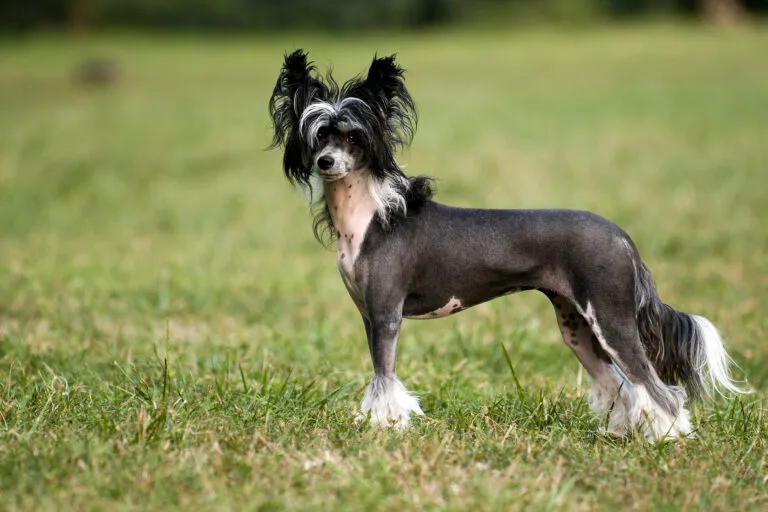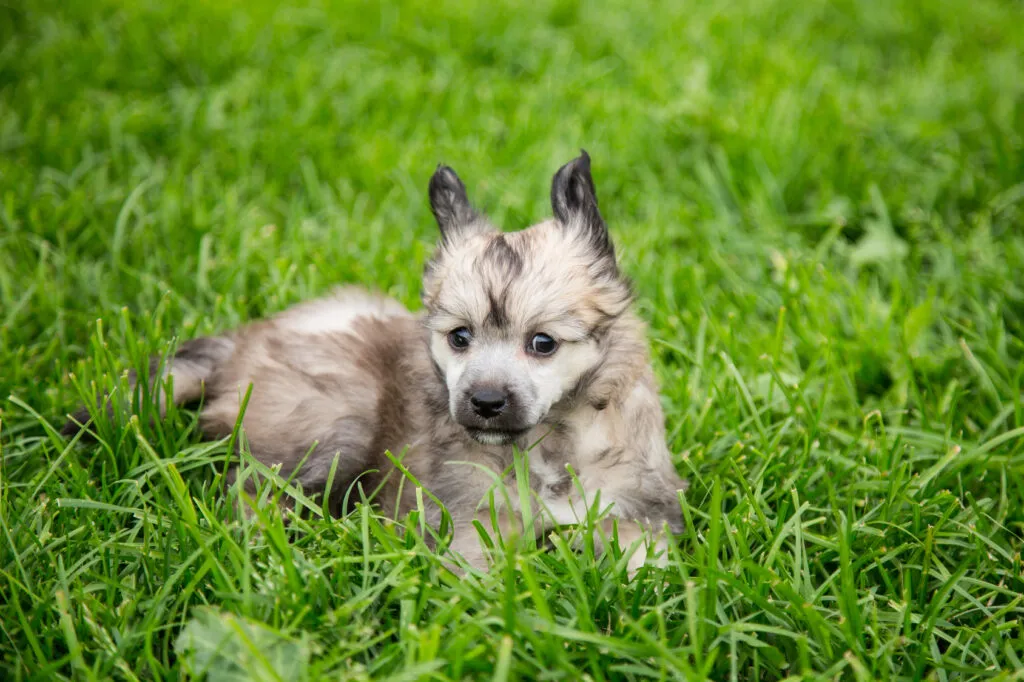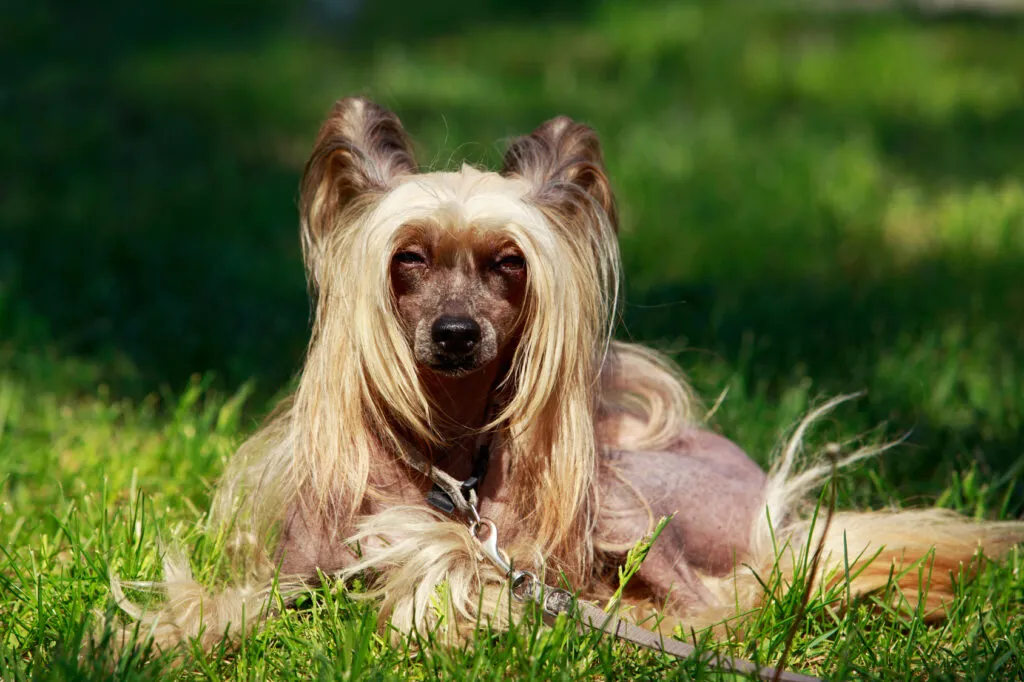Medium Size Poodle
This little dog is a polarising figure: Some people love it, others chuckle at the appearance of what seems to be a pampered fashion pup. Yet the Chinese Crested Dog is a robust, lively creature with a history that stretches back thousands of years.

© B.Stefanov / stock.adobe.com
The Chinese Crested dog is a small dog breed cherished for its loving and playful nature.
A Chinese Crested Dog has a remarkable look, not only due to its unique furry features. As a hairless breed, it only has fur in select areas: the so-called “crest,” a cascade of hair that extends from the head to the neck. Additionally, the last two-thirds of the rod and the legs are covered in hair. Ideally, the hair on the extremities grows to “sock height.”
According to the standard, the fur can be any colour. Chinese Crested Dogs can reach a withers height of up to 33 cm and are bred either very delicately or more robust as the “cobby type.” The graceful head has barely any wrinkles and sits on a long, slender neck. The large, widely spaced eyes are medium-sized and very dark, appearing almost black. The big ears, set low and carried erect, are also quite striking.
Many associate the breed with hairlessness, but that’s not always the case: If you are interested in a Chinese Crested Dog with full-body fur, look into the “Powder Puff” variety. In Crested Dog litters, there are usually also hairy puppies because hairless dogs carry the gene for “hair.” Hairy Crested Dogs are essential for healthy breeding, as otherwise, there would be an increase in missing teeth—this defect is more likely to accompany hairlessness. In the hairy variants of the Crested Dog, droopy ears are also allowed.
 © Anastasiia / stock.adobe.com
© Anastasiia / stock.adobe.com
Whether the Chinese Crested Dog truly originates from China is not entirely certain. However, there is a long tradition of breeding hairless or nearly hairless companion dogs in the Middle Kingdom: Sources suggest possible ancestors of this breed as early as the 12th century BC. The ancestors of the Chinese Crested Dog likely experienced their first bloom during the Han Dynasty (206 BC – 220 AD). They were companions to the ruling class and served as companion dogs, and in larger variants, as hunting and guard dogs. Eventually, the first specimens arrived in the USA, where these bare-skinned dogs quickly gained fame through shows in the 1920s. They are closely related to the Mexican and Peruvian Hairless Dogs.
The FCI recognised the breed in 1987. In Europe, its popularity has grown in many countries in recent years: It is increasingly common to see these elegant dogs prancing through Europe’s streets. Representatives of the breed regularly win “Ugliest Dog” contests due to their striking appearance, an oddity that only endears them more to their many followers.
This dog loves its people! If you are looking for a trailer-like dog that craves constant contact with its human pack, a Chinese Crested Dog is a friend for life. It is attentive, sensitive, and as much as it adores the attention of its humans, it knows how to behave when needed, making it a great travel companion. This cheerful nature is also playful and easygoing. Although these dogs are curious and thus alert, meaning they will notify you of an approaching visitor, they do not tend to bark excessively.
In education, as so often, consistency is key. If you do not want the adult Crested Dog to sleep in your bed, do not allow the puppy on your soft sheets—no matter how cute it rolls up on them. If all human family members are consistent, training this breed is a breeze. Learning basic commands is ideally complemented by attending a dog school, where your dog will meet other dogs of different breeds and sizes. This not only further promotes socialisation but also provides a good foundation for making contacts with other pet owners and their dogs.
The initial impression is misleading: The breed is robust and can handle a frosty winter walk—as long as you keep moving. For young and older dogs and in extreme cold, it may be wise to provide your pet with protection in the form of a dog coat.
Also, protect it from too much sun! Especially light-coloured dogs are at risk of sunburn. Just as with humans, light-skinned dogs are more prone to sunburn. Like humans, the skin of hairless dogs changes colour under sunlight—they tan.
Genetically, some Chinese Crested Dogs may be predisposed to lens displacement in the eye and, as a result, glaucoma. There is a genetic test for this predisposition, which responsible breeders conduct before mating—ensure you see the test results before purchasing a puppy.
A healthy Chinese Crested Dog can live between 12 and 14 years.
As with any dog, an appropriate diet is the best health precaution for the Chinese Crested Dog! When choosing dog food, look for a high meat content, meaning meat should be the first ingredient listed—whether you choose dry food or wet food. Manufacturer guidelines for feeding amounts are only benchmarks.
Particularly for the “Hairless” variant of the Chinese Crested Dog, it’s easy to monitor waistlines. Hairless dogs can often eat a bit more than their furry counterparts without gaining weight. If your dog is carrying too much weight, adjust its diet accordingly. When switching to new dog food, always transition slowly by mixing increasing amounts of the new food into the old over several days to prevent hypersensitivity. Your little friend should always have fresh water available.
At first glance, it’s clear: the “hairless” variant requires minimal coat care! The sparse fur has additional advantages: The Hairless Chinese Crested Dog hardly ever smells like a wet dog, and no vermin can settle on its bare skin. Occasionally, you should bathe your Chinese Crested Dog and apply a skin lotion to manage dry skin.
In summer, use sun protection, especially for lightly pigmented, light-coloured dogs. Regularly check the claws and trim them if necessary. Ensure dental health—special dental hygiene snacks for dogs can prevent tartar. If you train your Crested Dog to accept tooth brushing as a puppy, you’ll contribute significantly to maintaining clean teeth.
 © deviddo / stock.adobe.com
© deviddo / stock.adobe.com
As much as these little joys enjoy cuddling: Exercise is also crucial! Many love to run and play. Agility for small dogs can be a great way to keep these dogs active. In snow, rain, or ice, you don’t need long walks with the Chinese Crested Dog, but you should keep it entertained in other ways.
How about teaching it some dog tricks, perhaps through clicker training? This strengthens the bond between you and your dog, exercises its clever mind, and usually provides mutual fun! Dog dancing or Dog Frisbee are also good options—try out what brings you the most delight together!
The friendly dog suits any dog lover who appreciates an affectionate, canine companion and can spend a lot of time with it. It is ideal for apartment living in a city. As it is easy to train, it is perfect for beginners. Anyone living with this remarkable breed must be prepared for frequent comments on its minimal fur and sometimes criticisms from the uninformed—owning a Chinese Crested Dog indeed draws attention.
This friendly dog gets along well with children—ensure it has places to retreat and teach children to treat it respectfully. This breeds deep friendships. Additionally, the Chinese Crested Dog can live well with other pets.
Before bringing home a new pet, consider who will care for it during illness or holidays. The Chinese Crested Dog can travel with you easily. Many accommodations now allow pets. Also, consider the ongoing expenses, including dog tax and insurance, high-quality food, and vet costs over the years.
It is often noted that the hairless Chinese Crested Dog suits those with dog hair allergies. However, this is not proven—some allergy sufferers fare better with the hairless variant, possibly because allergens spread less. Allergies are reactionary to the enzymes in animal saliva, not the fur itself, which adhere to the fur and elsewhere. However, some report stronger allergic reactions to the “hairless” dog. Don’t rely on hearsay; discuss with your doctor about your desire for a dog in advance.
Despite the breed’s growing popularity, Chinese Crested Dogs remain relatively rare. If you want one, look for a reputable breeder to ensure you get a genuine Crested Dog with papers. Reputable breeders invest significant time and resources in raising healthy, well-typed puppies, including careful selection of parent dogs and extensive socialisation and imprinting of the puppies.
Increasing breed popularity can lead to disreputable breeders interested in profit. Avoid breeders without association affiliation and offering cheap puppies. Poorly socialised dogs often have behavioural issues. Never buy from disreputable breeders out of pity—every purchased puppy leads to another suffering animal. Inform the local veterinary authority instead. The puppy will join your home at a minimum of eight weeks old, chipped, wormed, and with a valid vaccination pass—remember to keep vaccinations up to date.
For adopting an adult dog, the first stop is the local animal welfare organisation—many dogs seek new homes. However, finding a Chinese Crested Dog or related hairless breed here is rare. Online, you can find organisations specialising in hairless dog adoption—search for “Hairless Dogs in Need” or “Hairless Dog Adoption” for relevant associations in your country.
You’ve decided on a Chinese Crested Dog and found your new companion? Congratulations! Shorten your wait by preparing for its arrival. In addition to a dog bed and transport boxes in appropriate size—you can estimate based on the fully-grown dog—essential items include bowls and a dog lead with harness or collar. Depending on the season, a dog coat for the hairless variant is useful. Keep handy the current dimensions if your dog is still growing. Unsure? Buy the next larger size for a growing dog. A claw trimmer eases claw maintenance, especially as light dogs like the Crested Dog may require regular trimming. Have sun protection ready in summer to prevent sunburn. Toys complete the basic equipment.
We wish you a wonderful time with your special Chinese Crested Dog!
Fans of the Bearded Collie agree that those who aren't familiar with this dog breed simply have to get acquainted with it. And those who have experienced how a Bearded Collie bolts across meadows with its flowing fur, how it rolls around full of energy and joy and how it attentively and observantly takes into account its owners wishes become simply addicted to this original dog breed and its unique charm.
The Goldendoodle isn't a breed, but a pairing between Golden Retrievers and Medium or Standard Poodles. Marketed as a low-maintenance dog for allergy sufferers, this hybrid is enjoying increasing popularity amongst dog lovers, similar to the Labradoodle.